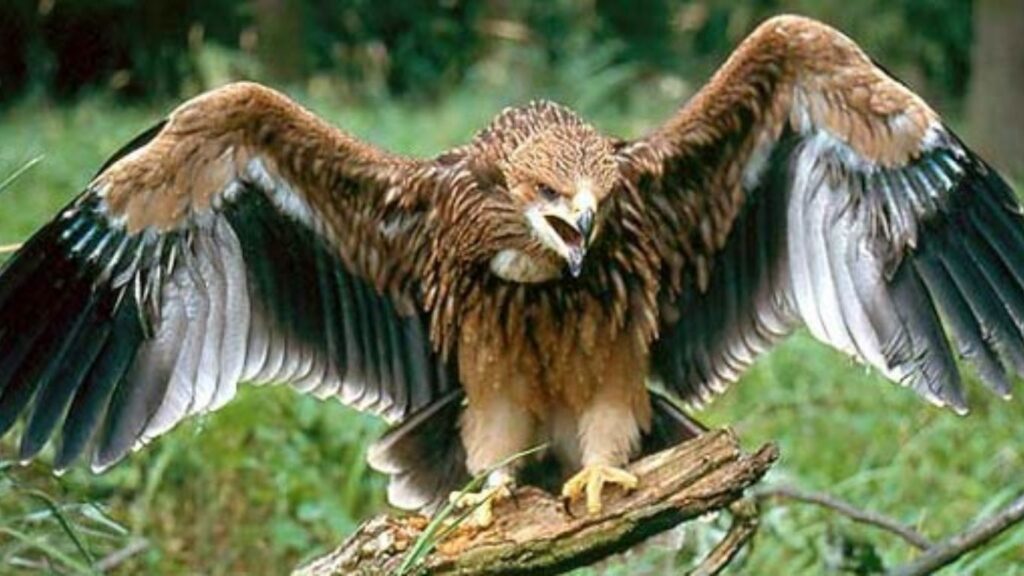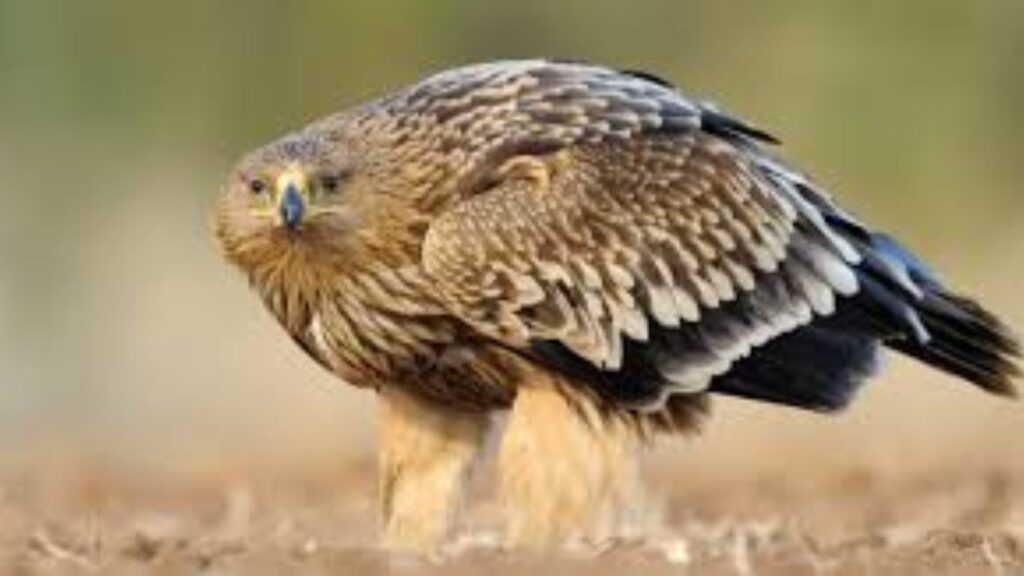The Eastern Imperial Eagle is a majestic bird of prey. It soars through the skies of Eurasia. This eagle is known for its power and grace. Let’s explore the fascinating world of this remarkable raptor.
Eastern Imperial Eagle Facts
The Eastern Imperial Eagle is a large bird of prey. It belongs to the family Accipitridae. This family includes eagles, hawks, and kites. The eagle is known for its impressive size and striking appearance.
These birds are apex predators in their ecosystems. They play a crucial role in maintaining ecological balance. Eastern Imperial Eagles are skilled hunters. They have excellent eyesight and powerful talons.
The species has cultural significance in many regions. It has been featured in folklore and national symbols. In some countries, it is considered a symbol of strength and nobility.
Eastern Imperial Eagle Size
Eastern Imperial Eagles are among the largest eagles in the world. They have a wingspan that can reach up to 2.15 meters (7 feet). Their body length ranges from 72 to 90 centimeters (28 to 35 inches).
These eagles weigh between 2.5 to 4.5 kilograms (5.5 to 9.9 pounds). Females are typically larger than males. This size difference is common in many raptor species.
Their large size helps them hunt effectively. It also makes them impressive in flight. Eastern Imperial Eagles can soar for hours using thermal currents.
Appearance

The Eastern Imperial Eagle has a distinctive appearance. Adults have dark brown plumage. Their head and nape are lighter, often appearing golden. This coloration gives them a regal look.
They have a large, powerful beak. It’s designed for tearing flesh. Their eyes are a striking yellow color. This feature adds to their fierce appearance.
The eagle’s legs are feathered. They end in large, sharp talons. These talons are crucial for catching and killing prey.
Sexual Dimorphism
Sexual dimorphism is present in Eastern Imperial Eagles. Females are larger than males. This size difference can be up to 10-15% in body mass.
Despite the size difference, both sexes have similar plumage. Color patterns are consistent between males and females. This makes it difficult to distinguish between sexes from a distance.
The size dimorphism likely evolved for breeding purposes. Larger females can better protect the nest and offspring.
Lifespan
In the wild, Eastern Imperial Eagles can live up to 20-25 years. However, many don’t reach this age due to various threats. In captivity, they may live even longer.
Their lifespan is influenced by several factors. These include habitat quality, food availability, and human interference. Juvenile eagles face higher mortality rates than adults.
The eagle’s long lifespan allows it to produce multiple offspring. This is important for the species’ survival. It also means that conservation efforts can have long-term impacts.
Scientific Name and Taxonomy
The scientific name of the Eastern Imperial Eagle is Aquila heliaca. It belongs to the genus Aquila, which includes several large eagle species.
The species was first described by Marie Jules César Savigny in 1809. It is closely related to the Spanish Imperial Eagle. Some scientists consider them subspecies of the same species.
Taxonomy helps scientists understand the eagle’s evolutionary history. It also aids in conservation efforts by clarifying relationships between species.
Eastern Imperial Eagle Distribution
Eastern Imperial Eagles have a wide distribution range. They are found across Eurasia, from Central and Eastern Europe to Central Asia. Their range extends into parts of the Middle East and South Asia.
Major breeding populations exist in Russia, Kazakhstan, and Mongolia. Smaller populations are found in other countries within their range. The eagles’ distribution has decreased over time due to habitat loss.
During winter, some populations migrate south. They can be found in parts of the Middle East, Northeast Africa, and the Indian subcontinent.
Eastern Imperial Eagle Habitat
These eagles prefer open landscapes. They are often found in steppes, grasslands, and agricultural areas. Forest-steppe mosaics are also favored habitats.
They require tall trees for nesting. These are often found near open areas where they hunt. In some regions, they have adapted to nesting on artificial structures like power pylons.
The quality of their habitat is crucial for survival. It affects their breeding success and overall population health. Habitat loss is a major threat to the species.
Eastern Imperial Eagle Population Size

The global population of Eastern Imperial Eagles is estimated at 3,500 to 15,000 mature individuals. This wide range reflects the difficulty in accurately counting these birds.
Population trends vary across their range. Some areas have seen declines, while others have stable or increasing populations. Conservation efforts have helped some populations recover.
Accurate population estimates are crucial for conservation. They help scientists and policymakers make informed decisions about protection measures.
Eastern Imperial Eagle Behavior
Eastern Imperial Eagles are known for their majestic flight. They soar effortlessly on thermal currents. This behavior helps them conserve energy while searching for prey.
These eagles are generally solitary or found in pairs. They become territorial during breeding season. Adults fiercely defend their nesting areas from intruders.
Juveniles may form small groups outside of breeding season. This behavior is thought to aid in learning hunting skills. As they mature, they become more solitary.
Feeding and Diet
The diet of Eastern Imperial Eagles is diverse. They primarily feed on small to medium-sized mammals. Common prey includes hares, ground squirrels, and marmots.
Birds also form a significant part of their diet. They hunt pheasants, partridges, and other ground-dwelling birds. In some areas, they may feed on waterfowl.
These eagles are opportunistic hunters. They sometimes feed on carrion, especially during winter. This adaptability helps them survive in various environments.
Breeding
Eastern Imperial Eagles typically reach sexual maturity at 3-5 years old. They form monogamous pairs that often mate for life. Breeding season varies depending on location.
Nests are built in tall trees or on cliffs. Sometimes they use artificial structures. Both parents participate in nest building and maintenance. Nests can be massive, reaching up to 2 meters in diameter.
Females usually lay 2-3 eggs. Incubation lasts about 43 days. Both parents share incubation duties. Chicks fledge after 60-77 days but may depend on parents for several more weeks.
Migration
Many Eastern Imperial Eagles are migratory. Northern populations typically move south for winter. Migration patterns vary depending on age and breeding location.
Adult birds often return to the same breeding territories each year. Juveniles may wander more widely before settling in a territory. Migration can cover thousands of kilometers.
During migration, eagles face various threats. These include illegal hunting and collisions with power lines. Conservation efforts often focus on protecting migration routes.
Eastern Imperial Eagle Conservation Status

The Eastern Imperial Eagle is classified as Vulnerable by the IUCN Red List. This status reflects the threats faced by the species. Population trends vary across its range.
Conservation efforts have shown some success. Populations have stabilized or increased in some areas. However, the species still faces significant challenges.
International cooperation is crucial for conservation. The eagle’s wide range means that efforts must span multiple countries. Protected areas play a key role in conservation strategies.
Threats
Several threats impact Eastern Imperial Eagle populations. Habitat loss is a major concern. Agricultural intensification and deforestation reduce suitable nesting and hunting areas.
Illegal hunting remains a problem in some regions. Eagles are sometimes shot or poisoned. Electrocution from poorly designed power lines is another significant threat.
Climate change may impact the eagles’ habitat and prey availability. Pollution and pesticides can affect their reproductive success. Addressing these threats requires comprehensive conservation strategies.
Frequently Asked Question
What is the main prey of Eastern Imperial Eagles?
The main prey includes small to medium-sized mammals and birds. Hares, ground squirrels, and pheasants are common targets.
How long do Eastern Imperial Eagles live?
In the wild, they can live up to 20-25 years. Captive birds may live even longer with proper care.
Are Eastern Imperial Eagles endangered?
They are classified as Vulnerable by the IUCN. This means they face a high risk of extinction in the wild.
Where do Eastern Imperial Eagles nest?
They typically nest in tall trees near open areas. Some populations have adapted to nesting on artificial structures.
Do Eastern Imperial Eagles migrate?
Many populations are migratory, especially those breeding in northern areas. They move south for winter.
Conclusion
The Eastern Imperial Eagle is a remarkable bird of prey. It faces numerous challenges but remains a symbol of power and grace. Conservation efforts are crucial for its survival.
Understanding this species helps protect it. Every aspect, from its behavior to its habitat needs, informs conservation strategies. The eagle’s fate is intertwined with the health of its ecosystems.
As we continue to study and protect the Eastern Imperial Eagle, we safeguard not just a species, but a part of our natural heritage. The future of this majestic bird depends on our actions today.

Brook with 5 years in celebrity styling. Transforms A-list looks into wearable trends.
Expert in red carpet glamour and everyday chic for the stars.





